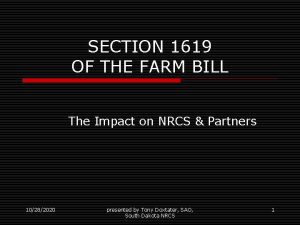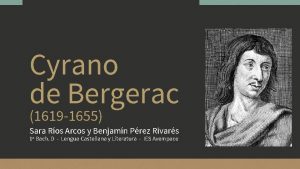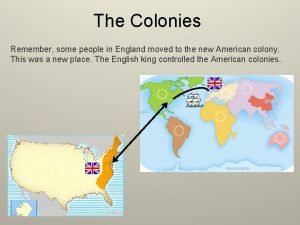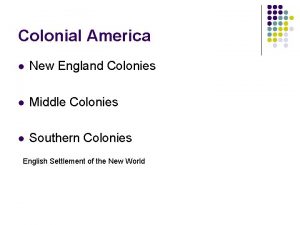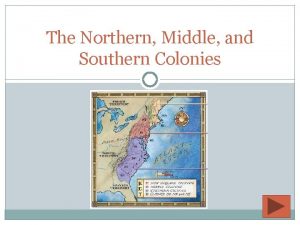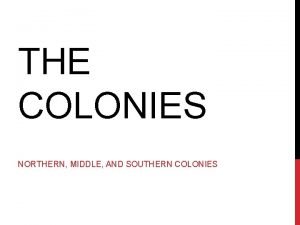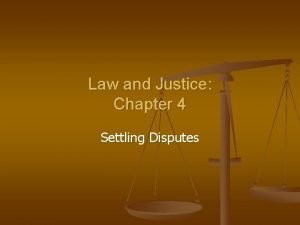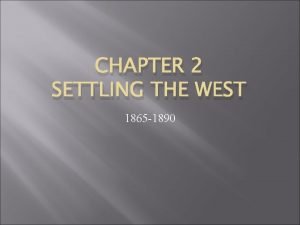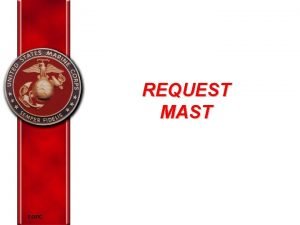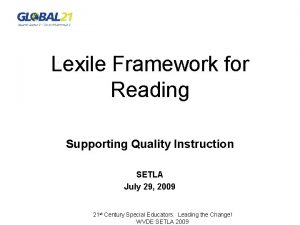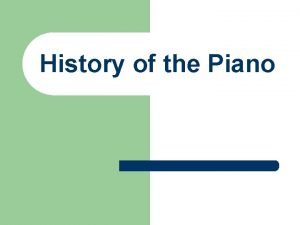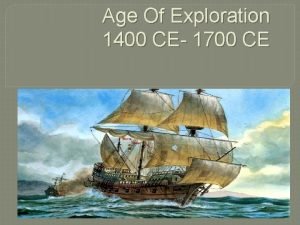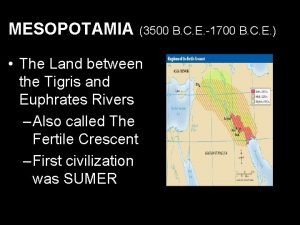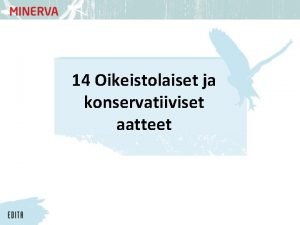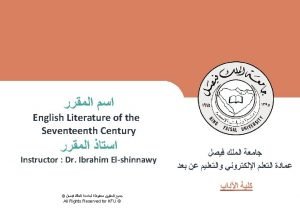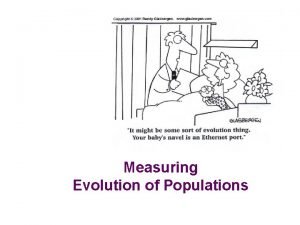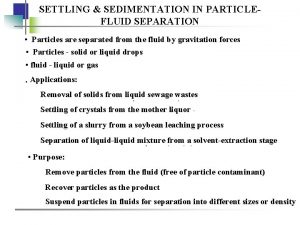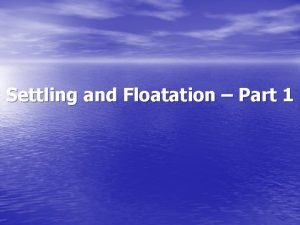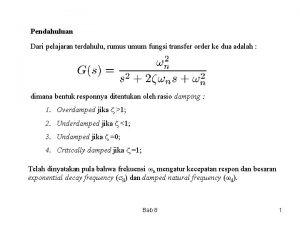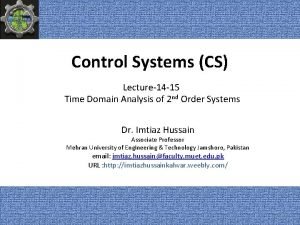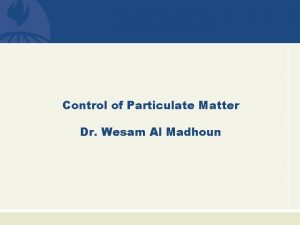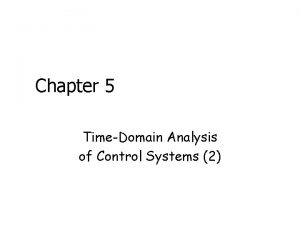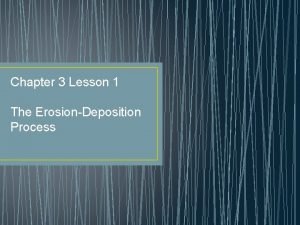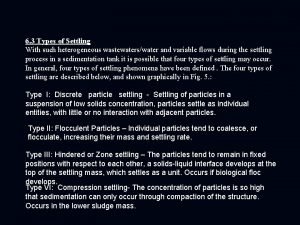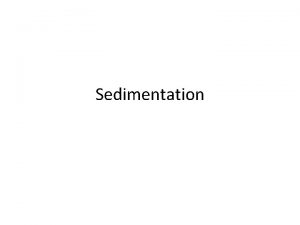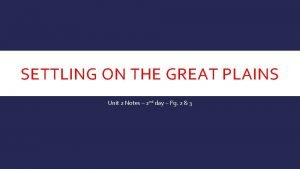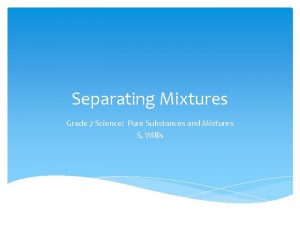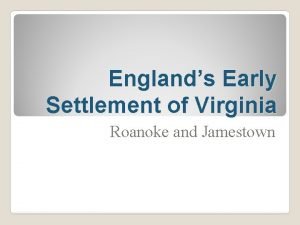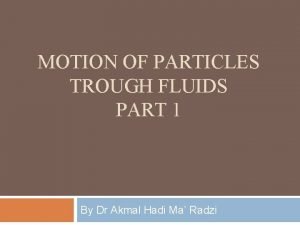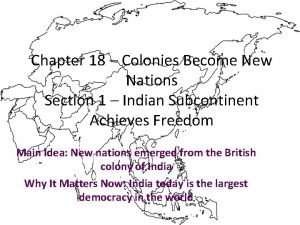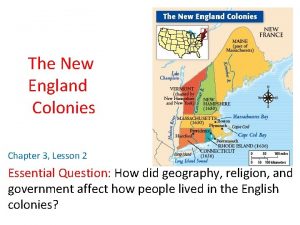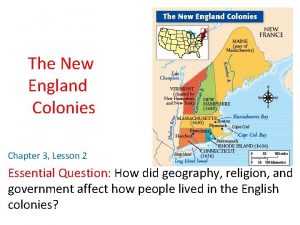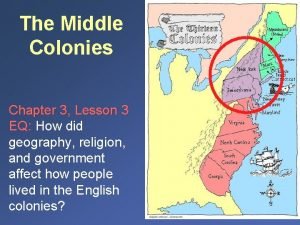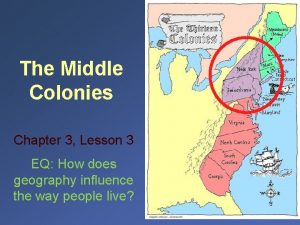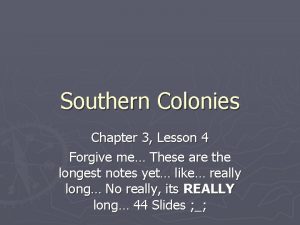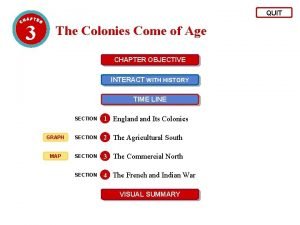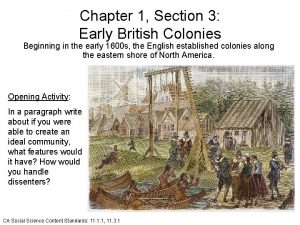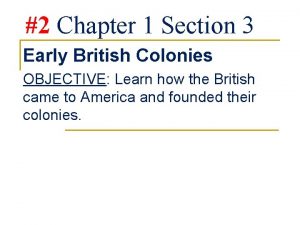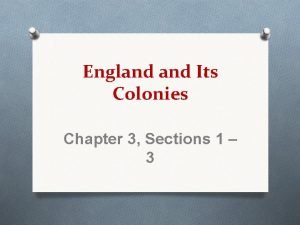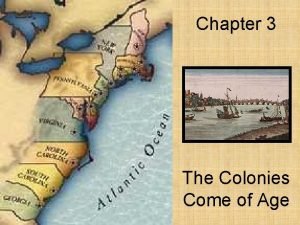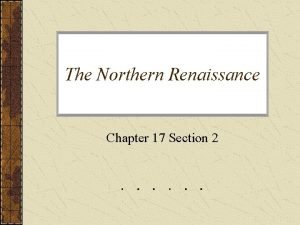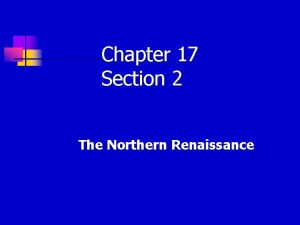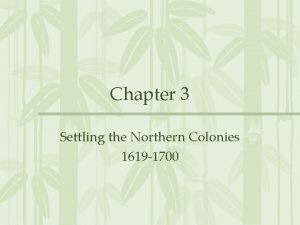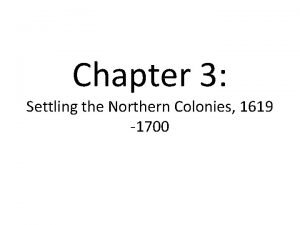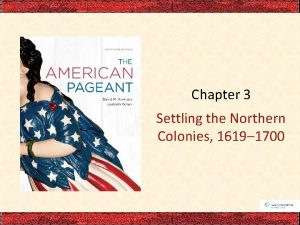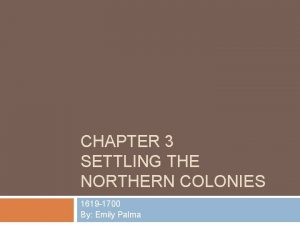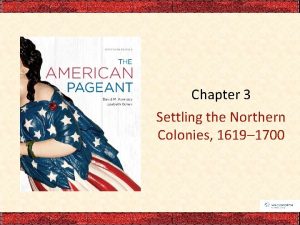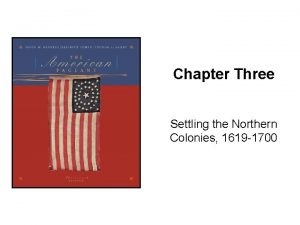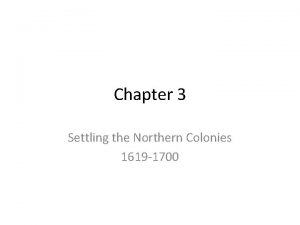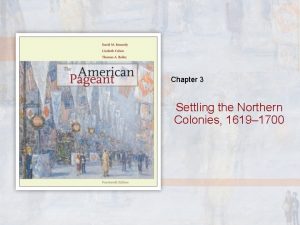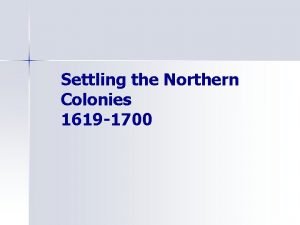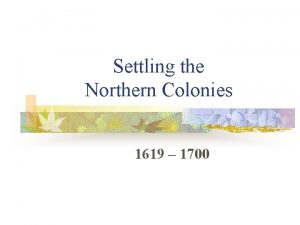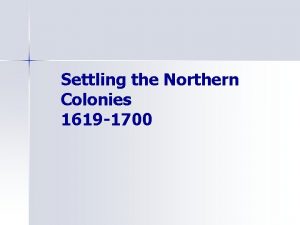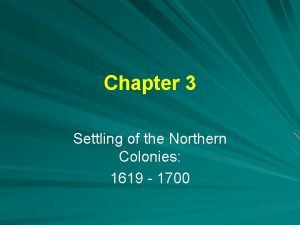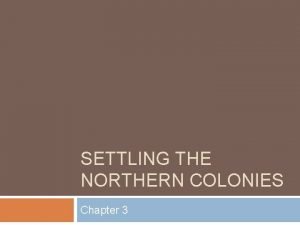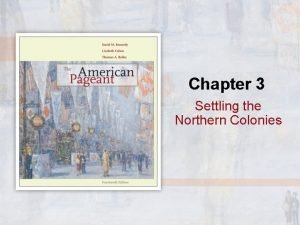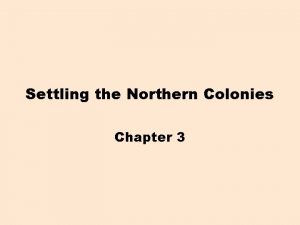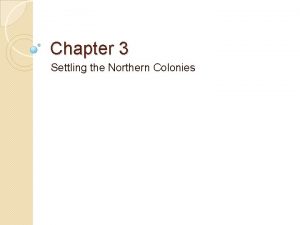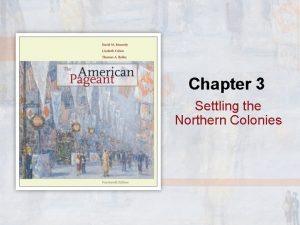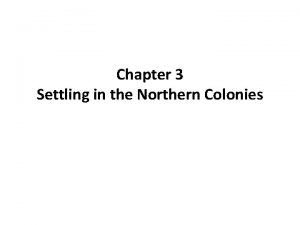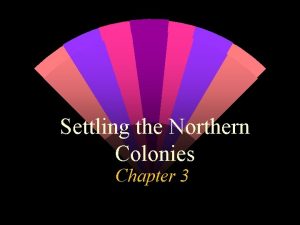Chapter 3 Settling the Northern Colonies 1619 1700





























































- Slides: 61

Chapter 3 Settling the Northern Colonies, 1619– 1700

I. The Protestant Reformation Produces Puritanism • 1517: Martin Luther began the Protestant Reformation. • John Calvin’s use of Luther’s ideas had a profound effect on the thought and character of America. • Calvinism became the dominant theological credo. • 1536: Calvin published Institutes of the Christian Religion.

I. The Protestant Reformation Produces Puritanism (cont. ) • Major doctrines of Calvinism are predestination—the elect are destined for eternal bliss and others for eternal torment —and conversion—the receipt of God’s free gift. • 1530 s: King Henry VIII broke with the Catholic Church. • Puritans: English religious reformers who wanted to purify English Christianity.

I. The Protestant Reformation Produces Puritanism (cont. ) • Controversy over church membership led to the Separatists breaking from the Church of England. • King James I (r. 1603– 1625) threatened to harass the bothersome Separatists out of England.

II. The Pilgrims End Their Pilgrimage at Plymouth • 1608: First Separatists fled to Holland, but over time they became distressed by the “Dutchification” of their children. • 1620: Some Separatists (known as Pilgrims) sailed on the Mayflower to Plymouth Bay. • Their Mayflower Compact was an agreement to form a government and submit to the will of the majority under some regulations. • Small settlement survived difficult early years.

p 43

III. The Bay Colony Bible Commonwealth • 1629: Charles I dismissed Parliament and persecuted Puritans. • 1630: Puritans founded Massachusetts Bay Colony. • 1630 s: 70, 000 refugees left England during the Great Migration (see Maps 3. 1; 3. 2).

Map 3. 1 a p 45

Map 3. 1 b p 45

III. The Bay Colony Bible Commonwealth (cont. ) • Like William Bradford in Plymouth, John Winthrop helped colony survive and prosper. • Winthrop believed he had a “calling” from God to lead the new religious experiment. • The Massachusetts Bay Colony became the biggest and most influential colony. • The first colonists believed they had a covenant with God to build a holy society as a model for all humankind.

IV. Building the Bay Colony • Franchise was extended to all “freemen”— adult males who belonged to Puritan congregations. • Unchurched men remained voteless. • The Bay Colony was not a democracy. • Nonbelievers and believers paid taxes for the government-supported church.

IV. Building the Bay Colony (cont. ) • John Cotton was a prominent leader in the Massachusetts “Bible Commonwealth. ” • Yet Puritans were a worldly lot. • The “Protestant ethic” involved serious commitment to work and worldly pursuits. • They enjoyed simple pleasures but passed laws to repress some human instincts. • Life to the Puritans was serious business.

V. Trouble in the Bible Commonwealth • Quakers, who flouted the authority of the Puritan clergy, were persecuted. • Anne Hutchinson’s antinomianism carried to extremes the doctrine of predestination. • 1638: She was brought to trial, then banished. • She left for Rhode Island then moved to New York, where she and her family were killed by Indians.

p 46

V. Trouble in the Bible Commonwealth (cont. ) • Roger Williams was an extreme Separatist. • He challenged clergymen to make a clear break with the Church of England; • He challenged the legality of the Bay Colony’s charter; • He challenged the civil authority to regulate religious behavior. • 1635: He was tried by the authorities.

VI. The Rhode Island “Sewer” • 1636: Williams, with the aid of Indians, fled to Rhode Island. • He built a Baptist church in Providence. • He established complete freedom of religion, even for Jews and Catholics. • He demanded no oaths. • He sheltered abused Quakers. • Rhode Island became the most liberal colony.

VI. The Rhode Island “Sewer” (cont. ) • Rhode Islanders: – Exercised simple manhood suffrage. – Achieved remarkable freedom of opportunity. • Rhode Island, planted by dissenters and exiles, became strongly individualistic and stubbornly independent.

VII. New England Spreads Out • The fertile Connecticut River area attracted a sprinkling of Dutch and English settlers. • 1635: Hartford was founded. • 1639: Connecticut’s Fundamental Orders was a modern constitution that established a regime democratically controlled by the “substantial” citizens. • 1638: New Haven was founded by Puritans.

Map 3. 2 p 48

VII. New England Spreads Out (cont. ) • 1677: Maine was absorbed by Massachusetts. • 1641: New Hampshire was absorbed by the Bay Colony. • 1679: King Charles II separated New Hampshire from Massachusetts and made it a royal colony.

VIII. Puritans Versus Indians • Before Pilgrims arrived in 1620, an epidemic killed over 75% of the native people. • Wampanoag Indians befriended the settlers. • 1621: Wampanoag chieftain Massasoit signed a treaty with the Plymouth Pilgrims. • 1621: The first Thanksgiving was celebrated. • Expanding settlement increased tensions. • 1637: Hostilities between Indians and whites exploded in the brutal Pequot War.

VIII. Puritans Versus Indians (cont. ) • Four decades of uneasy peace followed. • A few Puritan “praying towns” were established to Christianize remaining Indians. • 1675: Massasoit’s son Metacom (King Philip) forged intertribal alliance to resist settlers. • 1675– 1676: King Philip’s War slowed English settlement for a time, but overall inflicted a lasting defeat on Indians in New England.

p 49

IX. Seeds of Colonial Unity and Independence • 1643: Four colonies formed New England Confederation. • Its primary aim was defense against foes. • Each colony had two votes. • The confederation was essentially an exclusive Puritan club. • Its members were the Bay Colony, Plymouth, New Haven, and scattered valley colonies.

IX. Seeds of Colonial Unity and Independence (cont. ) • It was a milestone toward colonial unity. • Distracted by the English Civil War, England exercised benign neglect in the colonies. • As a result, colonists developed habits of relative independence. • 1660: King Charles II was restored and wanted to impose a much more active management of the colonies.

Table 3. 1 p 50

IX. Seeds of Colonial Unity and Independence (cont. ) • Massachusetts resisted Charles’s efforts. • 1662: Charles gave Connecticut a sea-to-sea charter that legalized squatter settlements. • 1663: He granted the outcasts in Rhode Island a new charter sanctioning religious tolerance. • 1684: London authorities revoked the Bay Colony’s charter.

X. Andros Promotes the First American Revolution • 1686: Royal authority created the Dominion of New England (see Map 3. 3). • It embraced New England, and two years later New York and East and West Jersey. • Navigation Laws attempted to link England’s overseas possessions more tightly to the English crown. • Sir Edmund Andros headed the Dominion.

X. Andros Promotes the First American Revolution (cont. ) • He generated hostility by his actions against self-government as well as smuggling. • 1688– 1689: The Glorious Revolution overthrew Catholic James II; enthroned Protestant rulers William III and Mary II. • It also caused the collapse of the Dominion. • Andros fled, but Massachusetts was still made into a royal colony in 1691.

p 51

p 51

Map 3. 3 p 51

X. Andros Promotes the First American Revolution (cont. ) • Many colonies struck against royal authority, including New York and Maryland. • In response, the new monarchs began a period of “salutary neglect” in enforcing the hated Navigation Acts. • Residues remained of Charles II’s effort to assert tighter colonial administrative control. • Many English officials were sent to colonies.

XI. Old Netherlanders at New Netherland • 16 th century: Netherlands rebelled against Catholic Spain. • 17 th century: Dutch golden age. • Dutch expanded their commercial and naval power to become a leading colonial power. • Dutch East India Company became powerful. • 1609: Henry Hudson ventured into Delaware Bay, New York Bay, and the Hudson River.

XI. Old Netherlanders at New Netherland (cont. ) • 1623– 1624: New Netherland was founded in the Hudson River area by the Dutch West India Company (see Map 3. 4). • They purchased Manhattan Island from the Indians. • New Amsterdam—later New York City—was a company town. • It was run by and for the Dutch company.

Map 3. 4 p 52

XI. Old Netherlanders at New Netherland (cont. ) • The investors had no enthusiasm for democratic practices. • A local body with limited lawmaking power was eventually established. • The colony developed a strong aristocracy as patroonships (feudal estates) were built. • New Amsterdam attracted a cosmopolitan population.

p 53

XII. Friction with English and Swedish Neighbors • The Dutch company-colony was beset by problems, especially with the Indians. • Settlers on Manhattan Island erected a wall, from which Wall Street derived its name. • People from Connecticut also ejected the Hollanders.

XII. Friction with English and Swedish Neighbors (cont. ) • 1638– 1655: Swedes trespassed on Dutch claims by planning New Sweden on the Delaware River (see Map 3. 4). • 1655: Resenting the Swedes, the Dutch dispatched a small military expedition. • Peter Stuyvesant successfully absorbed New Sweden into New Netherland.

XIII. Dutch Residues in New York • 1664: England seized New Netherland from the Dutch. • Charles II had granted his brother, the Duke of York, the former New Amsterdam area. • Peter Stuyvesant was forced to surrender. • New Amsterdam was renamed New York. • England gained a splendid harbor and the stately Hudson River.

XIII. Dutch Residues in New York (cont. ) • The English banner now waved over a stretch of territory from Maine to the Carolinas. • New York retained an autocratic spirit. • The Livingston and De Lancey families wielded disproportionate power. • This lordly atmosphere discouraged many European immigrants from coming.

XIII. Dutch Residues in New York (cont. ) • Dutch influence: – Place names – Gambrel-roofed architecture – Social customs and folkways (e. g. , Easter eggs, Santa Claus)

p 54

XIV. Penn’s Holy Experiment in Pennsylvania • Quakers, English dissenters known as the Religious Society of Friends: – refused to pay taxes for the established Church of England. – built simple meeting houses. – congregated without a paid clergy. – “spoke up” in meetings when moved. – kept their broad-brimmed hats on in the presence of “betters. ”

XIV. Penn’s Holy Experiment in Pennsylvania (cont. ) • Quakers (cont. ): – Addressed each other with simple “thee”s and “thou”s. – Took no oaths. • They were people of deep conviction: – Abhorred strife and warfare – Refused military service – Advocated passive resistance

XIV. Penn’s Holy Experiment in Pennsylvania (cont. ) • Quakers were simple, devoted, democratic people, contending for religious and civic freedom. • 1660: William Penn was attracted to the Quaker faith and suffered much persecution. • Penn’s thoughts turned to the New World. • He wanted to experiment with liberal ideas in government and to make money.

XIV. Penn’s Holy Experiment in Pennsylvania (cont. ) • 1681: He secured land from the king. • The king called the land Pennsylvania (“Penn’s Woodland”). • Pennsylvania was the best-advertised colony. • His liberal land policy also attracted many immigrants.

p 55

p 55

XV. Quaker Pennsylvania and Its Neighbors • 1681: Penn launched his colony: – Dutch, Swedish, English, and Welsh “squatters” were already there. – Philadelphia was carefully planned. – He bought land from the Indians and Chief Tammany. – He treated the Indians fairly. • Pennsylvania seemed, for a brief time, the land of amicable Indian-white relations.

p 56

XV. Quaker Pennsylvania and Its Neighbors (cont. ) • Quaker tolerance of non-Quaker immigrants eventually undermined Penn’s Indian policy. • Penn’s proprietary regime was unusually liberal and thus attracted many immigrants: – Representative assembly elected by landowners – No tax-supported state church – Freedom of worship – Restricted use of death penalty

XV. Quaker Pennsylvania and Its Neighbors (cont. ) • “Blue laws” prohibited “ungodly revelers, ” stage plays, playing cards, dice, games, and excessive hilarity. • The Quakers were shrewd businesspeople. • By 1700 the colony surpassed all other colonies but Virginia and Massachusetts in population and wealth. • Penn spent only four years in the colony.

XV. Quaker Pennsylvania and Its Neighbors (cont. ) • His enduring monument was a noble experience and a new commonwealth. • 1664: New Jersey was started by two nobles who received land from the Duke of York. • 1674: The Quakers bought West New Jersey. • Later East New Jersey was acquired. • 1703 Delaware was granted an assembly.

XV. Quaker Pennsylvania and Its Neighbors (cont. ) • Noted features of the colony: – No provision for a military defense – No restrictions on immigration – Strong dislike of slavery – Some progress toward social reform – Contained many different ethnic groups – Afforded economic opportunity, civil liberty, and religious freedom

XVI. The Middle Way in the Middle Colonies • Common features of New York, New Jersey, Delaware, and Pennsylvania: – They had extensive fertile soil. – They became the “bread colonies” because of grain exports. – Rivers like the Susquehanna, the Delaware, and the Hudson tapped the interior fur trade. – Industry stimulated commerce and the growth of seaports like New York and Philadelphia.

XVI. The Middle Way in the Middle Colonies (cont. ) • The middle colonies were midway between New England the southern plantations: – Landholding was intermediate in size. – Local government was between personalized town meetings of New England diffused county government of the South. – They had fewer industries than New England, but more than the South.

XVI. The Middle Way in the Middle Colonies (cont. ) • Distinctions of their own: – A more ethnically mixed population – An unusual degree of religious toleration and democratic control – Desirable land that was easier to acquire – Considerable economic and social democracy • All American colonies flourished under Britain’s continuing hands-off policies.

p 58

p 61
 Resolución 1619
Resolución 1619 Farm tools 1619
Farm tools 1619 Arcos 1619
Arcos 1619 13 colonies new england middle and southern
13 colonies new england middle and southern Northern middle and southern colonies venn diagram
Northern middle and southern colonies venn diagram Southern colonies
Southern colonies Northern middle southern colonies
Northern middle southern colonies Chapter 4 settling disputes
Chapter 4 settling disputes Settling the west 1865-1890
Settling the west 1865-1890 Mco1700.23f
Mco1700.23f Lexile analyzer
Lexile analyzer Nfpa 1700
Nfpa 1700 Piano 1700
Piano 1700 1700 ce
1700 ce 3500 + 1700
3500 + 1700 Eta 1700
Eta 1700 Rivoluzione agricola 1700
Rivoluzione agricola 1700 1700 luvun aatesuunta
1700 luvun aatesuunta Rotazione quadriennale 1700
Rotazione quadriennale 1700 The puritan age (1600 to 1660)
The puritan age (1600 to 1660) To resize an embedded chart, ____.
To resize an embedded chart, ____. Mechanisms of evolution
Mechanisms of evolution Mobility express 設定 cli
Mobility express 設定 cli 1700 bce
1700 bce Primary settling
Primary settling Hazen formula for settling velocity
Hazen formula for settling velocity Stokeslaw
Stokeslaw Differential settling method
Differential settling method Example of flotation and settling
Example of flotation and settling Rumus fungsi transfer
Rumus fungsi transfer Esp electrodes
Esp electrodes Clarifier tank in wastewater treatment
Clarifier tank in wastewater treatment Settling time
Settling time Settling time control system
Settling time control system Wesam al madhoun
Wesam al madhoun Maximum overshoot formula
Maximum overshoot formula Laying down or settling of eroded material
Laying down or settling of eroded material Gravitational settling chamber
Gravitational settling chamber Types of settling
Types of settling Settling velocity
Settling velocity An ideal horizontal flow settling basin
An ideal horizontal flow settling basin Settling on the great plains section 2
Settling on the great plains section 2 Separating mixtures grade 7
Separating mixtures grade 7 Account transfer in front office
Account transfer in front office Settling jamestown
Settling jamestown Settling the west part 2 packet- farming the plains
Settling the west part 2 packet- farming the plains Define terminal settling velocity
Define terminal settling velocity Settling time formula
Settling time formula The colonies become new nations
The colonies become new nations The colonies become new nations
The colonies become new nations New england colonies religion
New england colonies religion Lesson 2 the new england colonies answer key
Lesson 2 the new england colonies answer key Who founded pa
Who founded pa Guided reading lesson 3 the middle colonies answer key
Guided reading lesson 3 the middle colonies answer key Chapter 3 lesson 4 the southern colonies
Chapter 3 lesson 4 the southern colonies Chapter 3 the colonies come of age
Chapter 3 the colonies come of age Chapter 1 section 3 early british colonies
Chapter 1 section 3 early british colonies Chapter 1 section 3 early british colonies
Chapter 1 section 3 early british colonies Chapter 3 section 1 england and its colonies
Chapter 3 section 1 england and its colonies Chapter 3 the colonies come of age
Chapter 3 the colonies come of age Northern renaissance literature
Northern renaissance literature A northern renaissance artist who also published books was
A northern renaissance artist who also published books was

